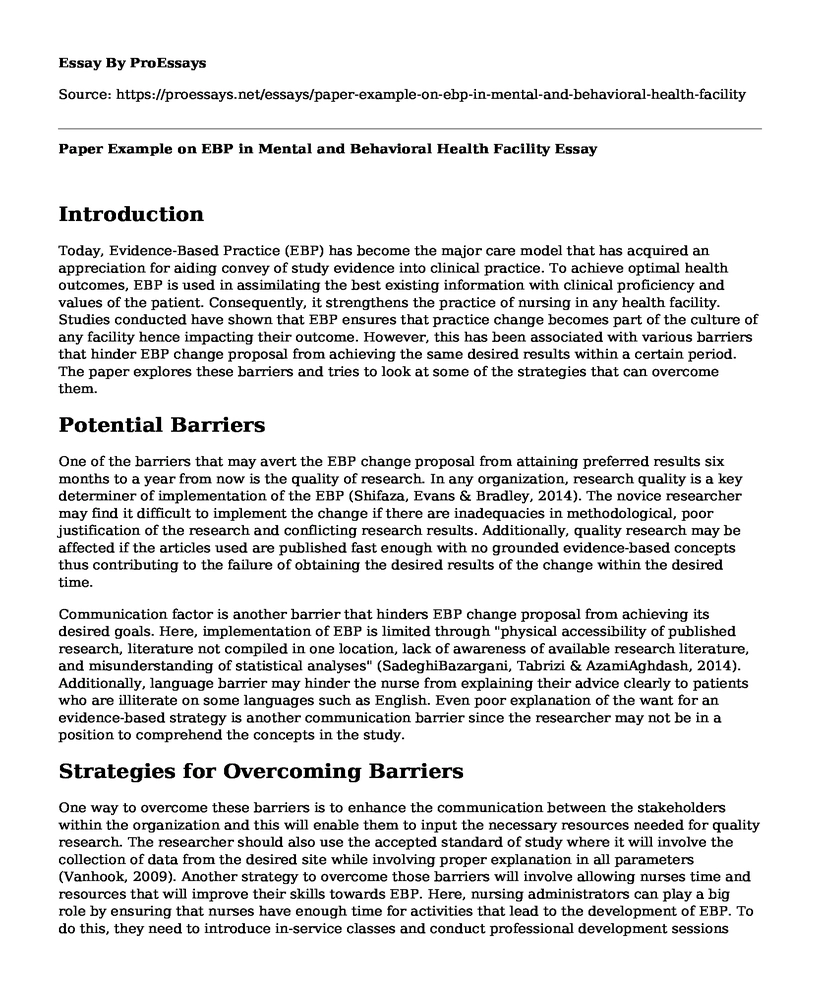Introduction
Today, Evidence-Based Practice (EBP) has become the major care model that has acquired an appreciation for aiding convey of study evidence into clinical practice. To achieve optimal health outcomes, EBP is used in assimilating the best existing information with clinical proficiency and values of the patient. Consequently, it strengthens the practice of nursing in any health facility. Studies conducted have shown that EBP ensures that practice change becomes part of the culture of any facility hence impacting their outcome. However, this has been associated with various barriers that hinder EBP change proposal from achieving the same desired results within a certain period. The paper explores these barriers and tries to look at some of the strategies that can overcome them.
Potential Barriers
One of the barriers that may avert the EBP change proposal from attaining preferred results six months to a year from now is the quality of research. In any organization, research quality is a key determiner of implementation of the EBP (Shifaza, Evans & Bradley, 2014). The novice researcher may find it difficult to implement the change if there are inadequacies in methodological, poor justification of the research and conflicting research results. Additionally, quality research may be affected if the articles used are published fast enough with no grounded evidence-based concepts thus contributing to the failure of obtaining the desired results of the change within the desired time.
Communication factor is another barrier that hinders EBP change proposal from achieving its desired goals. Here, implementation of EBP is limited through "physical accessibility of published research, literature not compiled in one location, lack of awareness of available research literature, and misunderstanding of statistical analyses" (SadeghiBazargani, Tabrizi & AzamiAghdash, 2014). Additionally, language barrier may hinder the nurse from explaining their advice clearly to patients who are illiterate on some languages such as English. Even poor explanation of the want for an evidence-based strategy is another communication barrier since the researcher may not be in a position to comprehend the concepts in the study.
Strategies for Overcoming Barriers
One way to overcome these barriers is to enhance the communication between the stakeholders within the organization and this will enable them to input the necessary resources needed for quality research. The researcher should also use the accepted standard of study where it will involve the collection of data from the desired site while involving proper explanation in all parameters (Vanhook, 2009). Another strategy to overcome those barriers will involve allowing nurses time and resources that will improve their skills towards EBP. Here, nursing administrators can play a big role by ensuring that nurses have enough time for activities that lead to the development of EBP. To do this, they need to introduce in-service classes and conduct professional development sessions that will enable nurses to initiate the required EBP change for attaining the continuous desired results. Language barriers can be overcome by involving a translator in the practice who will translate the information given by the nurse to the patient. Practitioners including nurses should carry out training so as to understand the good communication of evidence-based strategies and their importance in clinical practice (Lundgren et al., 2012). Additionally, national policies that have specific implications for EBP are required so as to ensure there is sustained change and as a result, it will lead to successful implementation of EBP change in an organization within the desired time.
References
Lundgren, L., Chassler, D., Amodeo, M., D'Ippolito, M., & Sullivan, L. (2012, September 15). Barriers to implementation of evidence-based addiction treatment: a national study. Journal of substance abuse treatment, 42(3), 231-238. https://bobcat.militaryfamilies.psu.edu/sites/default/files/placed-programs/amodeo,%20lundgren,%20cohen,%20rose,%20chassler%20et%20al%202011%20-%20implementation.pdf
Shifaza, F., Evans, D., & Bradley, H. (2014, November 9). Nurses' perceptions of barriers and facilitators to implementing EBP in the Maldives. Advances in Nursing, 2014. https://www.hindawi.com/journals/anurs/2014/698604/
SadeghiBazargani, H., Tabrizi, J. S., & AzamiAghdash, S. (2014, July 5). Barriers to evidencebased medicine: a systematic review. Journal of evaluation in clinical practice, 20(6), 793-802. https://www.arcjournals.org/pdfs/ajnh/v3-i1/1.pdf
Vanhook, P. M. (2009, October 11). Overcoming the barriers to EBP. Nursing management, 40(8), 9-11. https://journals.lww.com/nursingmanagement/Citation/2009/08000/Overcoming_the_barriers_to_EBP.3.aspx
Cite this page
Paper Example on EBP in Mental and Behavioral Health Facility. (2022, Aug 15). Retrieved from https://proessays.net/essays/paper-example-on-ebp-in-mental-and-behavioral-health-facility
If you are the original author of this essay and no longer wish to have it published on the ProEssays website, please click below to request its removal:
- Research Paper on Schizophrenia and Bipolar Mania
- Essay on Acadia Pharma: Improving CNS Health With Innovative Therapies
- Whole 30 Diet Program: Avoiding Health Issues & Living a Healthy Life - Essay Sample
- Essay Example on Vaping Devices: Benefits & Risks of Nicotine-Based E-Liquids
- Paper on Baptist Health System's 4Ps Marketing Strategy: A Case Study
- Essay Example on Optimizing Shift Exchange for Nurses: SIPOC Method
- Essay Example on Second Language Learning: Cognitive & Affective Factors







